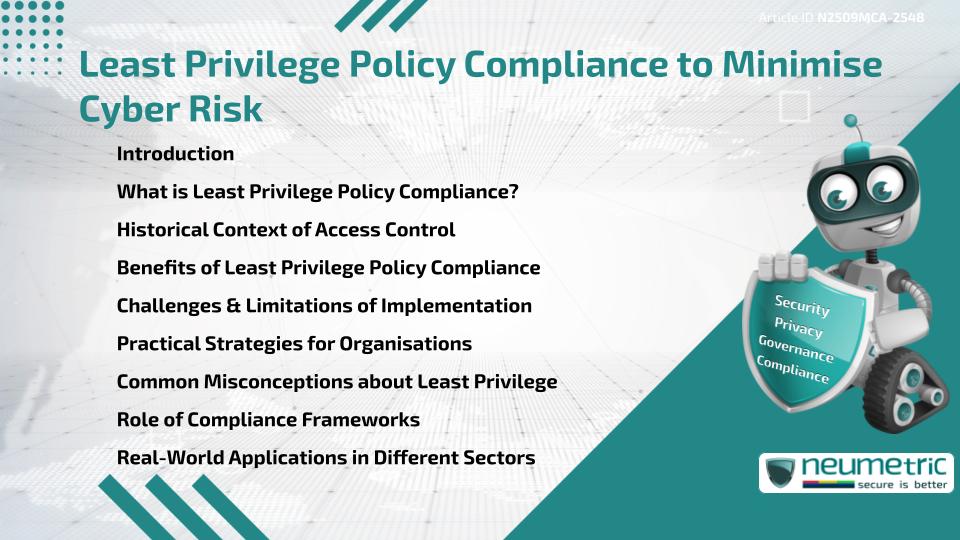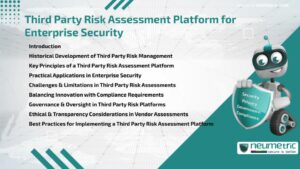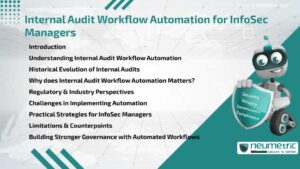Table of Contents
ToggleIntroduction
Least privilege policy compliance is a Cybersecurity practice that restricts User & system access rights to only what is strictly necessary. This principle reduces the Risk of data breaches, insider Threats & misuse of Sensitive Information. By ensuring Employees & systems operate with minimal permissions, organisations strengthen their security posture while meeting regulatory requirements. However, implementing least privilege policy compliance comes with challenges such as balancing productivity, technical limitations & change management. This article explores its meaning, history, benefits, limitations & practical strategies for minimising cyber Risk.
What is Least Privilege Policy Compliance?
Least privilege policy compliance refers to enforcing Access Control where users, systems & applications receive only the minimum level of permissions needed to perform their duties. For example, a marketing executive should not have administrative access to Finance systems. This principle applies across operating systems, databases, cloud environments & enterprise networks.
Unlike general access restrictions, compliance requires consistent enforcement, monitoring & auditing to align with internal Policies & external regulations such as GDPR & HIPAA.
Historical Context of Access Control
The idea of restricting access is not new. Early mainframe computing in the 1960s introduced the concept of privileged accounts to separate administrators from regular users. As networks expanded, operating systems like Unix incorporated permission structures, forming the foundation of modern Access Control models.
Over time, high-profile breaches highlighted the danger of excessive privileges. Incidents involving insider misuse demonstrated how unchecked access can cause more damage than external attacks, pushing least privilege into the centre of security frameworks.
Benefits of Least Privilege Policy Compliance
Organisations gain multiple benefits by implementing least privilege policy compliance:
- Reduced attack surface: With fewer permissions, attackers have limited opportunities to escalate privileges
- Insider Threat mitigation: Employees cannot access systems unrelated to their roles, reducing the potential for misuse.
- Regulatory alignment: Many compliance frameworks explicitly require least privilege.
- Improved operational control: Access is easier to manage when permissions follow a clear principle.
In practice, it works like locking only the doors necessary to secure a house rather than leaving every entryway open.
Challenges & Limitations of Implementation
While highly effective, least privilege policy compliance is not without obstacles.
- Productivity concerns: Employees may feel slowed down if they lack access to required resources.
- Complex environments: Large organisations often run hybrid systems, making consistent enforcement difficult.
- Legacy applications: Some older systems require broader permissions to function correctly.
- Cultural resistance: Employees accustomed to wide access may resist restrictions.
These challenges mean organisations must balance strict security with usability.
Practical Strategies for Organisations
To succeed with least privilege policy compliance, organisations should adopt structured approaches:
- Role-based Access Control (RBAC): Assign permissions based on job functions rather than individuals.
- Just-in-time access: Grant temporary elevated privileges only when necessary
- regular Audits: Review permissions periodically to identify excessive or outdated access rights.
- Automation: Use identity & access management [IAM] tools to enforce Policies consistently.
- Training: Educate Employees on why access restrictions matter.
These strategies help reduce friction while maintaining compliance.
Common Misconceptions about Least Privilege
Several misconceptions prevent organisations from adopting least privilege policy compliance effectively:
- “It reduces productivity too much”: Proper planning & tools ensure Employees still have timely access.
- “It only applies to administrators”: Every account, from end-users to service accounts, requires restrictions.
- “Once set, it doesn’t need review”: Access requirements change as roles evolve.
Addressing these misconceptions helps improve adoption.
Role of Compliance Frameworks
Many security & regulatory frameworks require or recommend least privilege policy compliance. Examples include:
- ISO 27001: Requires Access Controls aligned with least privilege.
- NIST Cybersecurity Framework: Recommends privilege restriction as part of identity management.
- HIPAA: Mandates limited access to patient health information.
Aligning with these standards not only improves security but also demonstrates compliance to auditors.
Real-World Applications in Different Sectors
Least privilege policy compliance plays a role across industries:
- Healthcare: Restricts access to electronic health records based on job function.
- Finance: Limits access to payment processing systems to reduce fraud Risks.
- Government: Applies strict compartmentalisation to protect classified data.
- Cloud services: Uses fine-grained identity Policies to control resource access.
Each sector adapts the principle to its own operational & regulatory needs.
Conclusion
Least privilege policy compliance is one of the most practical & effective ways to minimise cyber Risk. By limiting access, organisations reduce Vulnerabilities, strengthen defences against insider Threats & align with Global Standards.
Takeaways
- Least privilege restricts access to only what is necessary.
- It reduces insider Threats & attack surfaces.
- Compliance requires auditing, monitoring & enforcement.
- Challenges include productivity, legacy systems & culture.
- Effective strategies include RBAC, just-in-time access & automation.
FAQ
What does least privilege policy compliance mean?
It means granting users & systems only the minimum access required for their tasks while ensuring enforcement & auditing.
Why is least privilege policy compliance important?
It reduces the chances of cyber attacks, insider Threats & regulatory violations.
Does least privilege apply only to administrators?
No, it applies to every account, including service & end-user accounts.
How does least privilege policy compliance reduce cyber Risk?
By limiting permissions, attackers & insiders cannot escalate privileges or misuse systems.
What challenges exist in implementing least privilege?
Challenges include Employee resistance, legacy systems & maintaining productivity.
How often should organisations review access permissions?
Reviews should occur regularly, often quarterly or bi-annually, depending on Risk appetite.
Which compliance frameworks require least privilege?
Standards such as ISO 27001, HIPAA & NIST include least privilege requirements.
Can automation help in least privilege policy compliance?
Yes, automation through IAM tools simplifies monitoring & enforcement.
Need help for Security, Privacy, Governance & VAPT?
Neumetric provides organisations the necessary help to achieve their Cybersecurity, Compliance, Governance, Privacy, Certifications & Pentesting needs.
Organisations & Businesses, specifically those which provide SaaS & AI Solutions in the Fintech, BFSI & other regulated sectors, usually need a Cybersecurity Partner for meeting & maintaining the ongoing Security & Privacy needs & requirements of their Enterprise Clients & Privacy conscious Customers.
SOC 2, ISO 27001, ISO 42001, NIST, HIPAA, HECVAT, EU GDPR are some of the Frameworks that are served by Fusion – a SaaS, multimodular, multitenant, centralised, automated, Cybersecurity & Compliance Management system.
Neumetric also provides Expert Services for technical security which covers VAPT for Web Applications, APIs, iOS & Android Mobile Apps, Security Testing for AWS & other Cloud Environments & Cloud Infrastructure & other similar scopes.
Reach out to us by Email or filling out the Contact Form…





